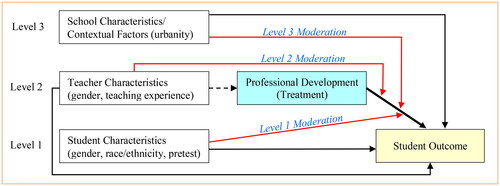Figures & data
Table 1. List of design and software modules of three-level multisite cluster randomized trials (MCRTs).
Table 2. Summary of standardized noncentrality parameters, MDESD and 100*(1-α)% confidence intervals for three-level MCRTs.
Figure 2. Power from simulation and formulas.
Note. Simulation results were based on 2,000 replications. Under the assumptions: The intraclass correlation coefficients at Level-2 and 3: = 0.1, and
= 0.2; The proportions of variances at level 1 and level 2 explained by covariates:
=
= 0.50; The proportion of clusters assigned to the treatment group, P = 0.5;
=
=
= 0.5 for binary moderators. For random slope models, the standardized effect variability of the moderation across sites for Level-1 moderator (
) and Level-2 moderator (
) are 0.05, the standardized variability of the treatment effect across sites for Level-3 moderator (
) is 0.09, the standardized effect variability of Level-1 moderator across Level-2 units (
) is 0.05, the moderator effect size = 0.20, sample size per level-2 unit (n) is 20, sample size per site (J) is 10, and total sample size of sites (K) is 20. For nonrandom slope models, the moderator effect size = 0.10, sample size per level-2 unit (n) is 20, sample size per site (J) is 4 for level 1 moderator and 10 for levels-2 and 3 moderators, and total sample size of sites (K) is 20 (except for binary level-1 moderator, K = 40).


